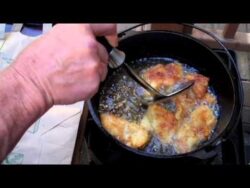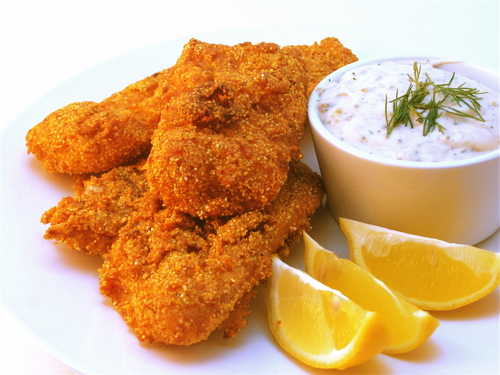 Fried fish is delicious! Fresh fried fish is even better. Icemen love to eat the frozen lakes bounty. There are so many varieties of fish to enjoy. Trout are common in many lakes. Perch, pike, walleyes, ling, and kokanee salmon are also common, tasty choices.
Fried fish is delicious! Fresh fried fish is even better. Icemen love to eat the frozen lakes bounty. There are so many varieties of fish to enjoy. Trout are common in many lakes. Perch, pike, walleyes, ling, and kokanee salmon are also common, tasty choices.
There are several things to consider when frying fish. If you avoid paying attention to any of these tips, your fried fish will be raw, soggy, overcooked, or a waste. Here are some Fry Facts to remember.
FRY PAN The type of fry pan that you use is important. If I am having a big fish fry, I use a deep fryer. Normally, around the house, on a tailgate, or for a shore lunch, I use a cast iron Dutch Oven. They hold heat well, the high sides reduce splatter, and you can lean/ hook a thermometer on the side.
OIL Flavored olive oils have become the new norm. Just a little of these flavored infused oils can offer a tasty outcome. My favorite is Blood Orange Olive Oil. Once you try this, you will always have it around. Peanut oil adds a nice flavor but there is a risk of fire at high temperatures. Canola oil is a safe and perfect oil to fry with. Saving and reusing oil is tricky. Oil used to fry fish or seafood will always add that flavor to everything else you use it for. You can strain and store the oil in a sealed glass container. I have been told to toss an aspirin into the oil. Restaurants that fry foods have disposal recycle units. The depth of the oil needs to be halfway up the thickness of the fish. Too much and the fish will be soggy and oily. Less oil is better than a pool full.
TEMPERATURE Keeping the oil at a consistent temperature is critical. Too hot and the fish will burn, too cool and the fish will be raw and soggy. 375 degrees is the magic number. Wait for the temperature to stabilize between frying batches. Always use a thermometer.
FISH TEMPERATURE Before you fry fish, let them get to room temperature. This is more of a concern when using thawed out frozen fish. Fish that are properly wrapped and frozen can be great for 3-4 months. Any longer and they become freezer burned or lose texture. The colder the filet, when you place it into the hot oil, the faster the oil will cool and prevent proper cooking.
BEST FISH Some fish are best fried. Oily/ fatty fish like salmon, smoked, tuna, and larger trout, are best baked, raw, or cooked in other ways. Smaller trout are tasty when fried. Most white meat fish have less fat and are also good fryers. White fish also have a milder flavor and be spiced to your personal taste.
BATTER UP A dry batter is simple and can be spiced to your needs. My go to spice is Old Bay seasoning. I add it to complete, dry pancake batter mix. You can also use flour. Make sure to add some salt to help bring out the flavors. Bready batters require a dredge of eggs, milk, and flour or fish breading. You want a batter to be the thickness of cream. Panko batter uses club soda. A beer Batter uses a pilsner brew to add flavor and moisture to the breading. Don’t overcoat the battered fish. You want a thin, crispy coating, not a thick bready, soggy, and greasy crust.
NO TOWELS Draining cooked fish on paper towels will not remove all the oil. The top and bottom of the filets will also dry/cool differently. Use a wire rack to drain a single layer of fish. Cooking fish in batches will help keep the fish warm and consistent. Serve soon after frying. Fish stacked in a bowl on top of other fish with a paper towel on the bottom will end up soggy and crumbly.
GET SAUCY Fish sauces can complement fried fish. A nice Tartar sauce is fine. There are many other spice blends to add to sauces. You may want hotter flavors for fish tacos or tastes. Explore some flavors to enhance your fish. Fresh tomatoes and veggies are also good to go with fish sandwiches.
KILL IT and CHILL IT Most importantly, if you plan to eat the fish you catch, flavor begins with when the fish is in the net. Quickly kill the fish using a club, stick, or knife. You do not want the fish flopping around the cooler or on a stringer. When they do this, lactic acid will build up in their meat and change the flavor. Keep the dead fish cool. Once the fish is dead, they will immediately begin to decompose. Cooling slows down this process. Icemen do not need an ice chest. The lake is a perfect cooldown for freshly caught fish. During warmer conditions use an ice chest to keep the catch healthy and fresh.
Enjoy the fish you catch. They are healthy, tasty, and a welcome contribution to the family menu and budget.
Montana Grant




